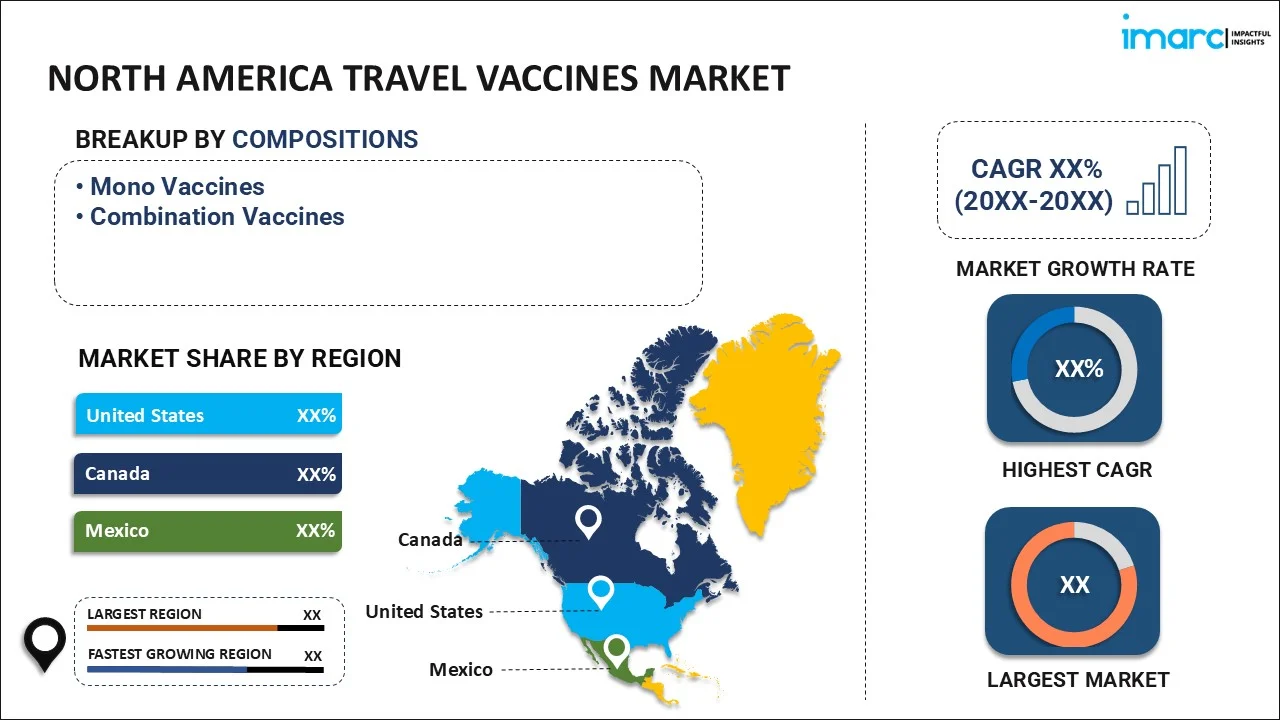
North America Travel Vaccines Market Report by Composition (Mono Vaccines, Combination Vaccines), Disease (Hepatitis A, DPT, Yellow Fever, Typhoid, Hepatitis B, Measles and Mumps, Rabies, Meningococcal, Varicella, Japanese Encephalitis, and Others), and Country 2025-2033
Market Overview:
The North America travel vaccines market size reached USD 2.01 Billion in 2024. Looking forward, IMARC Group expects the market to reach USD 3.24 Billion by 2033, exhibiting a growth rate (CAGR) of 5.5% during 2025-2033.
|
Report Attribute
|
Key Statistics
|
|---|---|
|
Base Year
|
2024
|
|
Forecast Years
|
2025-2033
|
|
Historical Years
|
2019-2024
|
|
Market Size in 2024
|
USD 2.01 Billion |
|
Market Forecast in 2033
|
USD 3.24 Billion |
| Market Growth Rate 2025-2033 | 5.5% |
Vaccines are defined as biological preparations that protect the human body against severe and potentially deadly diseases. They generally consist of an agent made from the surface protein, toxins, weakened or killed forms of the disease-causing microorganisms. Vaccination enables the body to produce antibodies, which provide a shield in case the person is exposed to the disease. For travel vaccines, also known as travel immunizations, travelers are vaccinated 4 to 6 weeks before the journey. These can be differentiated between recommended and required vaccines. Wherein, required vaccines are essential for the individual to get before entering a country. However, recommended vaccines are those which the traveler may need because of a potential infection threat in the country or a part of that country. Some of the most common vaccine-preventable, travel-related diseases include influenza, meningitis, rabies, tick-borne encephalitis, polio, diphtheria, tetanus, pertussis, etc.
North America travel vaccines market is currently being driven by several factors. One of the key factors driving the demand of travel vaccines is their ability to prevent the risk of disease epidemic. Moreover, vaccination provides immunity to individuals, travelling to places where there is a high risk of exposure or contracting a specific disease. As a result, governments in the region have mandated vaccination before visiting certain destinations with a high prevalence of infectious diseases. Other factors driving the demand of travel vaccines in the region include rising number of travelers, government initiatives, technological advancements such as combination vaccines and needle free techniques, etc.

Key Market Segmentation:
IMARC Group provides an analysis of the key trends in each segment of the North America travel vaccines market report, along with forecasts at the regional and country levels from 2025-2033. Our report has categorized the market based on composition and disease.
- Key Regions Analysed
- United States
- Canada
- Mexico
- Analysis for Each Country
- Market by Composition
- Mono Vaccines
- Combination Vaccines
- Market by Disease
- Hepatitis A
- DPT
- Yellow Fever
- Typhoid
- Hepatitis B
- Measles and Mumps
- Rabies
- Meningococcal
- Varicella
- Japanese Encephalitis
- Others
- Value Chain Analysis
- Key Drivers and Challenges
- Porters Five Forces Analysis
- PESTEL Analysis
- Government Regulations
- Competitive Landscape
- Competitive Structure
- Key Player Profiles
Report Coverage:
| Report Features | Details |
|---|---|
| Base Year of the Analysis | 2024 |
| Historical Period | 2019-2024 |
| Forecast Period | 2025-2033 |
| Units | Billion USD |
| Segment Coverage | Composition, Disease, Country |
| Countries Covered | United States, Canada, Mexico |
| Customization Scope | 10% Free Customization |
| Post-Sale Analyst Support | 10-12 Weeks |
| Delivery Format | PDF and Excel through Email (We can also provide the editable version of the report in PPT/Word format on special request) |
Key Questions Answered in This Report
The North America travel vaccines market was valued at USD 2.01 Billion in 2024.
We expect the North America travel vaccines market to exhibit a CAGR of 5.5% during 2025-2033.
The high prevalence of travel-related diseases, such as influenza, meningitis, tick-borne encephalitis, etc., is primarily driving the North America travel vaccines market.
The sudden outbreak of the COVID-19 pandemic has led to the rising adoption of novel coronavirus vaccine as a mandate travel requirement for international travelers in North America to avoid the risk of infection.
Based on the composition, the North America travel vaccines market has been segmented into mono vaccines and combination vaccines. Currently, combination vaccines hold the majority of the total market share.
Based on the disease, the North America travel vaccines market can be divided into hepatitis A, DPT, yellow fever, typhoid, hepatitis B, measles and mumps, rabies, meningococcal, varicella, Japanese encephalitis, and others. Among these, hepatitis A currently represents the largest market share.
On a regional level, the market has been classified into United States, Canada, and Mexico, where the United States currently dominates the North American market.
Need more help?
- Speak to our experienced analysts for insights on the current market scenarios.
- Include additional segments and countries to customize the report as per your requirement.
- Gain an unparalleled competitive advantage in your domain by understanding how to utilize the report and positively impacting your operations and revenue.
- For further assistance, please connect with our analysts.
 Inquire Before Buying
Inquire Before Buying
 Speak to an Analyst
Speak to an Analyst
 Request Brochure
Request Brochure
 Request Customization
Request Customization




.webp)




.webp)












